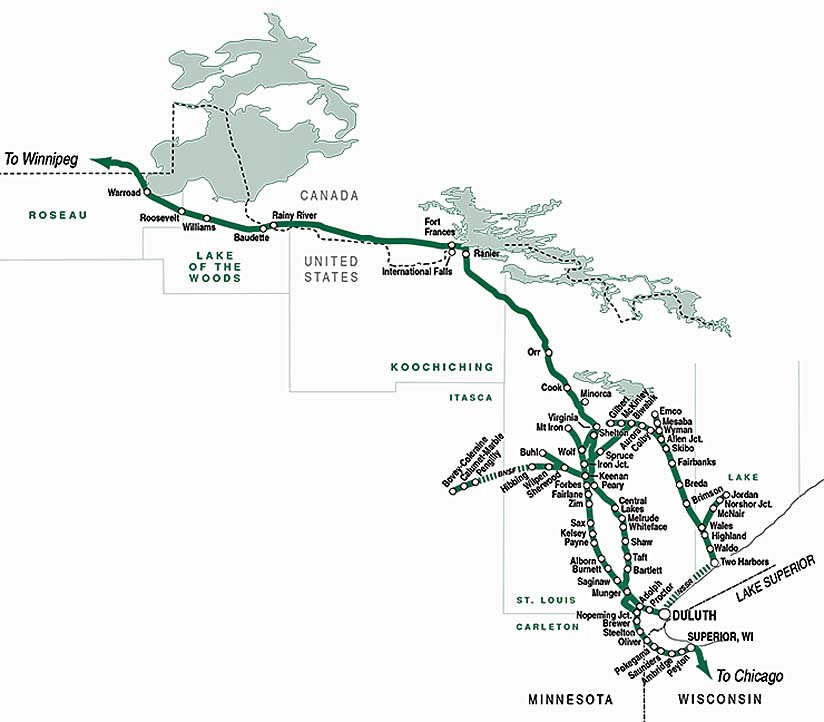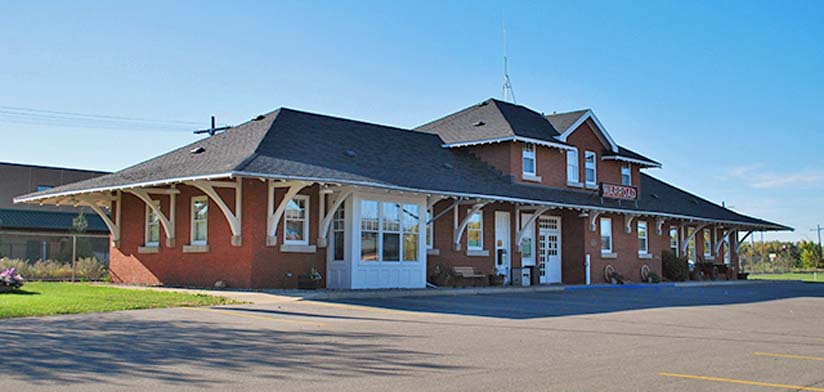
Minnesota USA - One of the things I remember from visiting my father's hometown of Warroad along the Minnesota-Canada border, was watching
the trains go by from the front window of my grandparents' home on Lake Street.
I could see the CN logo on the trains and learned that this stood for Canadian National (CN).
My grandma sometimes watched with me and told me a few stories about riding trains when she was a girl in the 1910s.
Her father was a station agent for the Soo Line, and she had been born in Wimbledon, North Dakota, when he was the agent there.
I thought about my grandmother and the CN over the past couple of weeks as news broke that Kansas City Southern Railway (KCS) had dropped its earlier plan to
merge with the Canadian Pacific Railway (CP) and instead had accepted a higher bid from CN.
Why were two Canadian companies bidding for this American railroad?
And what might it mean for Minnesota?
Out With CP and in With CN
CP and KCS announced their merger plans on 21 Mar 2021.
The deal seemed straightforward, combine a primarily east-west railroad (CP) with a primarily north-south enterprise (KCS) to create a new company that could
move commodities throughout North America.
The railroads' lines did not overlap, so neither side saw any problems getting permission for the combination from the Surface Transportation Board (STB), the
federal agency responsible for approving railroad mergers.
The situation changed one month later, on 21 Apr2021, when CN offered KCS shareholders about US$5 billion more than CP.
CP made it clear that it would not raise its bid, telling KCS's board, in effect, don't waste your time and money on a merger option that might be rejected by
U.S. regulators.
CP and KCS routes never overlap, while CN already has a north-south route running from Chicago to the Gulf of Mexico.
The STB might rule against a CN/KCS merger because it could reduce competition in the north-south freight market, and so CP argued, take the safe bet and merge
with us.
The KCS's board thought differently, and on 21 May 2021 they announced that they were backing out of their agreement with CP and accepting CN's
bid.
Everyone is now waiting for the STB to approve or disapprove the merger.
Why Did the Canadians Want KCS?
Donald Trump constantly complained that the North American Free Trade Agreement (NAFTA) was, "perhaps the worst trade deal ever made."
Businesses and transportation companies in Canada, the U.S., and Mexico, took this to mean that they should slow down or even stop plans they had to stretch
their supply chains further than they already had since NAFTA took effect in the 1990s.
The ambiguity lifted once the Trump Administration decided, in 2018, to work with its neighbors to revise NAFTA.
Canada, Mexico, and the U.S. signed the new United States Mexico Canada Agreement (USMCA) in 2019.
The USMCA created conditions under which producers could create new supply chains across the continent with certainty.
Railroads and trucking companies are at the heart of making these systems work, and KCS is both the only Class I railroad that crossed the Mexican border and
the smallest.
It was only a matter of time before the suitors came along.
Minnesota Roots of a Canadian Transcontinental
The map below shows the portion of CN's main route that runs through Minnesota.
It enters the U.S. near Warroad, runs to Baudette, crosses Canada to Rainy Lake, re-enters the U.S. at International Falls, and continues across the Arrowhead
region to Duluth.

The line I watched from my grandmother's window in Warroad dates to 1900 when the Canadian Northern Railway (CNoR), a forerunner of today's CN, decided
to connect their roads in southern Manitoba with their tracks in southwestern Ontario to form a transcontinental line across Canada.
The problem they faced was that Lake of the Woods sat between their two groups of railroads.
To link them up, should they take the long way and go north of the lake to keep the road entirely in Canada? (as the Canadian Pacific had done twenty years
earlier)
Or could they take a short cut south of Lake of the Woods through the U.S.?
Fortunately for the CNoR, it was able to purchase an American charter to build the Minnesota & Manitoba railroad.
CNoR was thus able to lay a line from the Canadian border north of Warroad (where their western lines ended) to Baudette, build a bridge across the Rainy
River, and link up with their tracks in southwestern Ontario.
Moving People and Goods
The CN line between Warroad and Baudette is "the only section of the Canadian transcontinental railway system which passes through the United
States," according to the National Park Service.
The Warroad depot, built by CNoR in 1914, "was made possible by a treaty between the two countries, and is believed to be the first depot in the United
States constructed by a foreign corporation."
It's now listed on the National Register of Historic Places due to its significance as a transit point for immigrants between Canada and the
U.S.
Thus, if you have ancestors who first landed in Canada, they may have arrived in Minnesota via Warroad.
Or, if you have relatives who moved from Minnesota to the Canadian plains of Manitoba or Saskatchewan, they might have left the U.S. through
Warroad.

The rails between International Falls and Duluth, built between 1909 and 1912, were originally known as the Duluth, Winnipeg, & Pacific Railroad
(DWP), a subsidiary of CNoR.
The idea was to link Winnipeg and Duluth by connecting the existing route from Winnipeg to Fort Francis, Ontario, to International Falls, and then to
Duluth.
The route was originally designed for hauling timber from the north woods to processing centers in the U.S. and Canada.
However, with the outbreak of World War I in 1914, it became clear that moving iron ore to the steel mills where it was fashioned into military armaments
would be profitable as well.
So, the company upgraded the rails to accommodate ore trains.
How Will the Potential Merger Affect Minnesota's Economy?
I see three possibilities for how the CN's purchase of KCS might affect Minnesota's economy.
The first is that nothing changes, that is, CP keeps its headquarters in Minneapolis, CN runs about the same amount of traffic freight through Minnesota, and
that's it.
The second, more likely option, is that CN starts running more freight along its Minnesota lines to feed both its existing north-south route to the Gulf of
Mexico and KCS's rails to Mexico.
CP continues to run its U.S. operations in Minneapolis.
The third scenario, and what I think is most likely, is that CN runs more trains on its Minnesota route and a U.S. railroad purchases CP.
If the CN/KCS merger is approved, CP becomes the smallest Class I railroad, and is a tempting target for a U.S. company that needs access to the west
coast.
Whoever gets CP can bypass the current behemoths on the West Coast (BNSF, CP, and the UP) and have direct access to the Pacific via British Columbia's
ports.
My guess is that Norfolk Southern (most likely) or CSX (possibly) will make a bid for CP.
Minneapolis would probably lose CP's U.S. headquarters to either Norfolk, Virginia (if Norfolk Southern wins) or Jacksonville, Florida (if CSX gets the
prize).
One thing is certain in all of this.
Just as I did over 50 years ago, kids will be able to watch CN trains roll through Warroad for a long time to come.
Louis D. Johnston.
 Would the Canadian Federal Government permit an American railroad takeover of Canada's National Dream?
Would the Canadian Federal Government permit an American railroad takeover of Canada's National Dream?
(because there was no image with original article)
(usually because it's been seen before)
provisions in Section 29 of the Canadian
Copyright Modernization Act.
